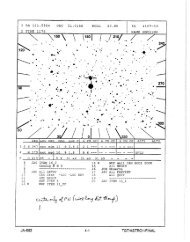The FUSE Archival Data Handbook - MAST - STScI
The FUSE Archival Data Handbook - MAST - STScI
The FUSE Archival Data Handbook - MAST - STScI
You also want an ePaper? Increase the reach of your titles
YUMPU automatically turns print PDFs into web optimized ePapers that Google loves.
Figure 2.3: Schematic view of the wavelength coverage, dispersion directions, and image locations<br />
for the <strong>FUSE</strong> detectors. In this figure, the detector pixel coordinates of the corner of each<br />
segment are shown. <strong>The</strong> X, Y axes indicate orientation on the sky. Wavelength ranges shown<br />
are approximate (see Table 2.2).<br />
<strong>The</strong> SiC channels had an average dispersive plate scale of 1.03 ˚A/mm while the LiF channels<br />
had a scale of 1.12 ˚A/mm (Moos et al. [2000]). Coupled with the detector pixel size, this resulted<br />
in a scale of ∼6.7 m˚A/pixel in the LiF channel and ∼ 6.2 m˚A/pixel in the SiC channel (in the<br />
X or dispersion direction).<br />
<strong>The</strong> optical design of the <strong>FUSE</strong> spectrographs introduced astigmatism. <strong>The</strong> astigmatic<br />
height of <strong>FUSE</strong> spectra perpendicular to the dispersion was significant; the dispersed image of<br />
a point source had a vertical extent of 200 – 900 µm, or 14 – 63 ′′ , on the detector. An extended<br />
source filling the large aperture was as large as 1200 µm, or 100 ′′ . This vertical astigmatic<br />
height was a function of both wavelength and detector segment. This meant that the spatial<br />
imaging capability of <strong>FUSE</strong> was extremely limited. For the spectral region near the minimum<br />
astigmatic heights in each spectrum, there was marginal spatial information (> 10 ′′ ), but to<br />
recover this requires careful, non-standard processing. <strong>The</strong> minimum astigmatic points were<br />
near 1030 ˚A on the LiF channels and near 920 ˚A on the SiC channels.<br />
Moreover, spectral features showed considerable curvature perpendicular to the dispersion,<br />
especially near the ends of the detectors where the astigmatism was greatest. This astigmatism<br />
is corrected for in the data prior to collapsing it into a 1-D spectrum (see Chapter 7 and the<br />
Instrument <strong>Handbook</strong> (2009) for details).<br />
6




